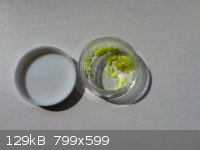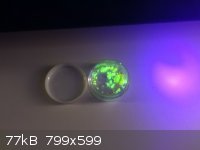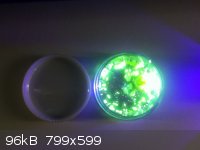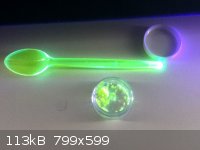DutchChemistryBox
Hazard to Self
 
Posts: 74
Registered: 24-3-2013
Location: Strasbourg
Member Is Offline
Mood: No Mood
|
|
Fluorescence of a plastic spoon
I was working on building my lab, my workbench was just painted, so I decided to get an ice-cream.
While eating the ice-cream I was fascinated by the color/fluorescence of my spoon. I couldn’t resist it to try isolating the stuff which was
responsible for the fluorescence.
My lab wasn’t/isn’t ready yet, so I had not much equipment and/or chemicals to try it.
I decided to try dissolving the spoon in 50ml of acetone, I added two spoons to the 50ml.
While stirring I heated the solution till it was boiling, the solution started to get greenish and a like gel looking precipitate settled down on the
bottom of the flask.
Then the solution was filtrated with an coffee-filter and the filtrate was evaporated till a solid was left over.
The solid does not dissolve and shows no reaction in water, ethanol and sulfuric acid. It doesn’t burn or react with heat, it just melts (with the
temperature of an alcohol burner).
I’ve attached some pictures of the spoon and the product.
I’ve no idea what I have just isolated, some polymers, a nice organic compound? Is it the stuff which is responsible for the fluorescence or is it
some plastic which is still contaminated with dye?
Does anybody have an idea what I’ve just isolated and how I can determine that? Or was I just wasting my time?
Anyway, it looks nice under UV.
   
|
|
|
phlogiston
International Hazard
    
Posts: 1375
Registered: 26-4-2008
Location: Neon Thorium Erbium Lanthanum Neodymium Sulphur
Member Is Offline
Mood: pyrophoric
|
|
I would be surprised if there was such a large amount of dye in the spoon. The quantity is usually only a small fraction of a percent, especially in
thick products like this spoon.
There are several fluorescent dyes available for plastics.... perhaps you can figure out which one it is if you know what the spoons are made of?
PMMA? Polystyrene?
-----
"If a rocket goes up, who cares where it comes down, that's not my concern said Wernher von Braun" - Tom Lehrer |
|
|
prof_genius
Hazard to Others
  
Posts: 147
Registered: 15-5-2013
Member Is Offline
Mood: No Mood
|
|
Where did you get the spoon? I want to try this for myself.
|
|
|
Endimion17
International Hazard
    
Posts: 1468
Registered: 17-7-2011
Location: shores of a solar sea
Member Is Offline
Mood: speeding through time at the rate of 1 second per second
|
|
I have the same damn spoon.
That's not the dye itself what you've "isolated". It's some goo made of disrupted polymer.
The dye is either a nonpolar compound in the form of solid solution inside the polymer, or the polymer chain itself has some chromophoric molecules
attached, though that's hardly the case and it's probably the biochemist par of my brain that thought of that. 
I guess so many polymer chains with chromophores, all tightly held together, would be susceptible to strong fluorescence quenching, not to mention the
cost of such polymer.
I guess a lot of what I've jut wrote is just fucking redundant, lol.
[Edited on 6-7-2013 by Endimion17]
|
|
|
DutchChemistryBox
Hazard to Self
 
Posts: 74
Registered: 24-3-2013
Location: Strasbourg
Member Is Offline
Mood: No Mood
|
|
According to the resin identification code it is made of polystyrene, maybe the dye is a rhodamine?
Tonight I'll go on a little vacation, so I have to look at it next week. You'll hear from me when I know more about it.
@prof_genius: The catering on our party last week gave them with the ice-cream.
|
|
|
Fantasma4500
International Hazard
    
Posts: 1677
Registered: 12-12-2012
Location: Dysrope (aka europe)
Member Is Offline
Mood: dangerously practical
|
|
if you like dyes you could try taking some duct tape (cheap brands or whatever) and reacting the sticky stuff with HNO3, i found out about this when i
tried to distill HNO3 so basically NO2 / 99% HNO3 was in contact with it
probably less concentrated would work
if you get the sticky yellow stuff on your hands you will have some yellow'ish marks on your hands for a long time, and the skin will peel right off,
cleaner than ever below
if you add ammonia to a solution with that yellow organic nitrate or nitrite in it turns red
got to think about this as its also slightly flouroscent, havent tried with UV however
it wasnt 'the real' duct tape, just some random cheap brand, probably works for other duct tape adhensives also
|
|
|
nezza
Hazard to Others
  
Posts: 324
Registered: 17-4-2011
Location: UK
Member Is Offline
Mood: phosphorescent
|
|
It looks about the colour of fluorescein, so could be styrene with a small amount of fluorescein dissolved in it as a solid solution. One way to help
identify it would be to measure the absorption/emission spectra (Assuming you have access to a spectrophotometer) and compare them to known dyestuffs.
|
|
|
Dr.Bob
International Hazard
    
Posts: 2658
Registered: 26-1-2011
Location: USA - NC
Member Is Offline
Mood: No Mood
|
|
It is likely fluorescein as nezza said. That is the cheapest fluorescent dye I know of, very easy to make with phthalic anhydride and resorcinol in
the presence of an acid catalyst. I ran that reaction as one of my first organic reactions. It is very soluble in most solvents, so it would likely
dissolve in polystyrene or might be built into the polymer by just adding a double bond to one of the rings in it. It glows green in tiny amounts,
especially at higher pH. It also provides the green color found in some antifreeze and other chemicals to help find leaks and spills.
|
|
|
DutchChemistryBox
Hazard to Self
 
Posts: 74
Registered: 24-3-2013
Location: Strasbourg
Member Is Offline
Mood: No Mood
|
|
Thanks, it indeed looks the same!
I don't have a spectrophotometer at home  , but we have a lot of spectrophotometer's
at school. Unfortunately the vacation is just started, so the next 2 month's I don't have acces to them. I'll isolate some more of the dye and then
I'll store it till I have the time to analyse it at school. , but we have a lot of spectrophotometer's
at school. Unfortunately the vacation is just started, so the next 2 month's I don't have acces to them. I'll isolate some more of the dye and then
I'll store it till I have the time to analyse it at school.
When I've learned some more about organic chemistry I'll try to synthese fluorescein myself and use that to compare my dye with.
|
|
|